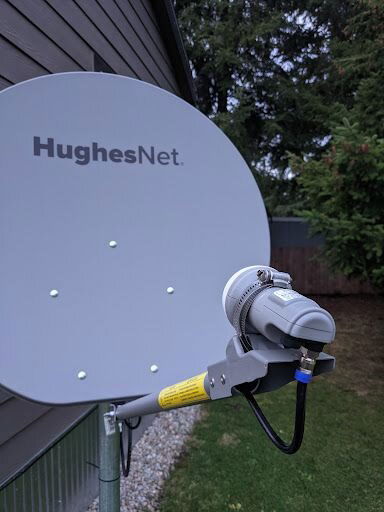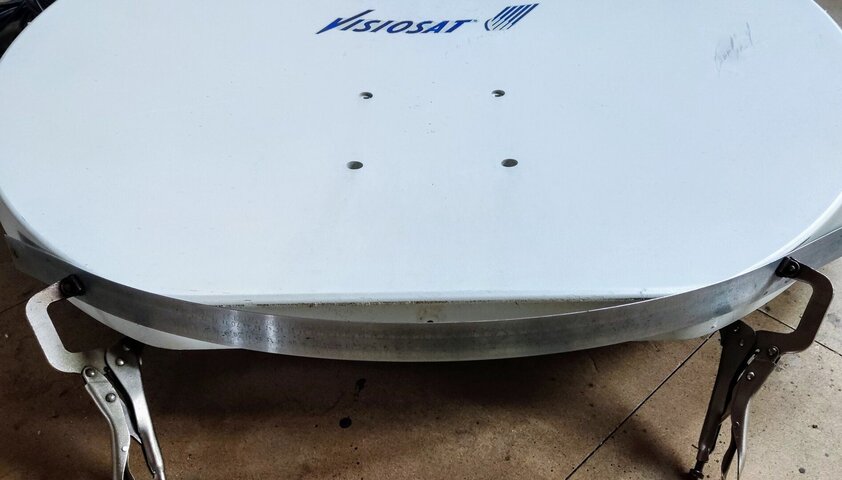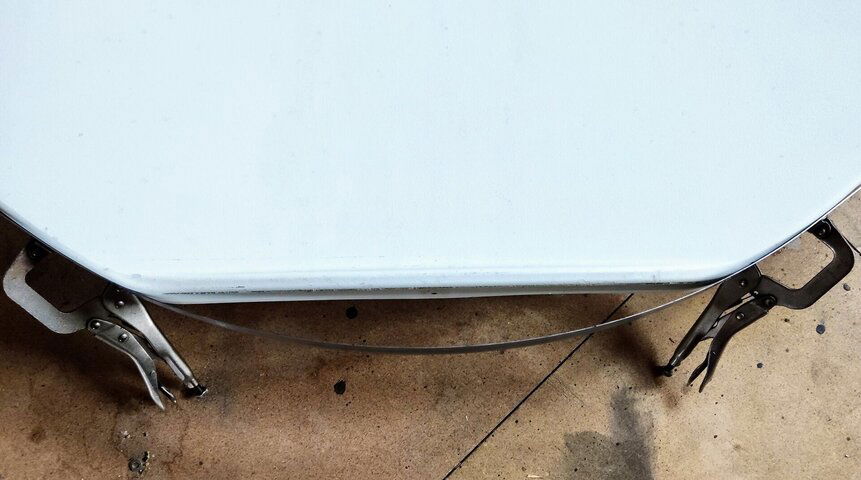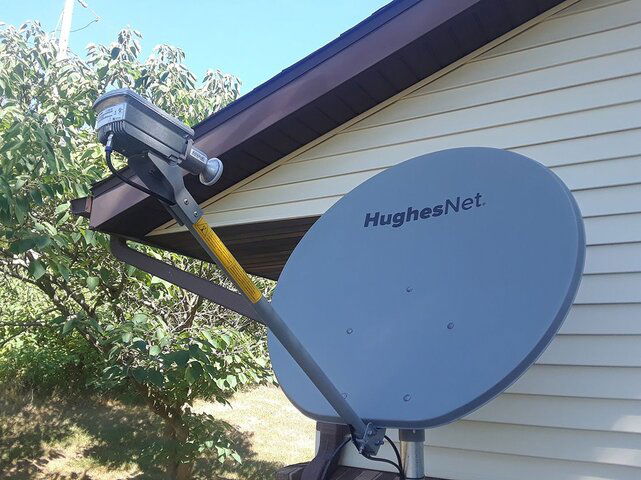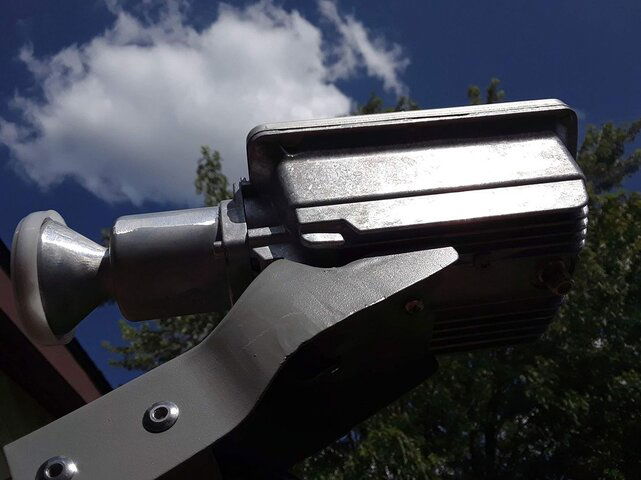While mounting my LNB, I noticed it seems a bit low by visual inspection. But after looking at various pictures of other dishes, this seems to be normal (see attached picture, of where I thought the LNB should be (red focus lines) compared to reality (the pictured LNB, well below the intersection)). Can anyone explain why this is so low down? Is the dish not really parabolic?

OTHER Question about LNB position
- Thread starter jessica6
- Start date
- Latest activity Latest activity:
- Replies 22
- Views 5K
You are using an out of date browser. It may not display this or other websites correctly.
You should upgrade or use an alternative browser.
You should upgrade or use an alternative browser.
The small dishes are "Offset dishes", which means the lnb is mounted much lower like the photo above. That's to help keep it from shadowing the signal. It "looks" much higher up for signal than you'd think, and then it bounces down to the lnb.
It IS a parabolic dish, but a 'section cut' of one, so the lnb is where it would belong, IF the dish was a true "prime focus" (like old school large C-band dishes)

 www.techsawa.com
www.techsawa.com
It IS a parabolic dish, but a 'section cut' of one, so the lnb is where it would belong, IF the dish was a true "prime focus" (like old school large C-band dishes)

Difference Between A Prime Focus And An Offset Dish - Techsawa
Many free to air satellite TV enthusiasts can easily tell the difference between an Prime focus and and Offset dish, they can even correctly predict which satellite a certain dish is facing just by looking at it, even from a moving vehicle. Well if you do not know the difference between a Prime...
And to add, still:
You'll notice that the deepest point (measured along the vertical mid plane of the dish) of an offset dish is not at the center, but below the center.
Even on the drawing in the post by Titanium, that can be seen.
(With a prime focus dishes, the deepest point is at the center.)
greetz,
A33
You'll notice that the deepest point (measured along the vertical mid plane of the dish) of an offset dish is not at the center, but below the center.
Even on the drawing in the post by Titanium, that can be seen.
(With a prime focus dishes, the deepest point is at the center.)
greetz,
A33
I conducted an experiment yesterday, based on an idea someone posted about using small mirrors on the dish. I tried this, then pointed the dish directly at the sun. I then found where all the dots focused. It was definitely not as low as I thought it would be, so apparently I don't have an offset dish? My experiment told me that the focus was pretty much right in the middle of the dish. My HughesNet dish is about 3' diameter.
I will need to extend my LNB arm about 1' up and towards the dish in order to get to the point where all the lights came together.
I found the dish information online, and the picture does look like the LNB is higher up that the offset dishes I've seen: HughesNet .90m Antenna Reflector (box 1 / 2, 3 pk)
Does this seem right?


I will need to extend my LNB arm about 1' up and towards the dish in order to get to the point where all the lights came together.
I found the dish information online, and the picture does look like the LNB is higher up that the offset dishes I've seen: HughesNet .90m Antenna Reflector (box 1 / 2, 3 pk)
Does this seem right?
Shes definitely an offset reflector. Plenty of photos here of prime focus dishes. See how your lnb is not right out in front and pointing at the center? It's offset. I've done the mirror and reflective mylar and even aluminum foil and rubber cement thing before on a freebie WildBlue Ka band dish with sub reflector.
Did you adjust the dish elevation to the elevation angle of the sun?I conducted an experiment yesterday, based on an idea someone posted about using small mirrors on the dish. I tried this, then pointed the dish directly at the sun. I then found where all the dots focused. It was definitely not as low as I thought it would be, so apparently I don't have an offset dish?
If the sun is not at the boresight direction of the dish, you'll find the sun beam is reflected at another offset angle..
When testing offset angle with mirrors, you have to adjust the dish's elevation to the sharpest possible mirrorred dot. Otherwise the test just gives you an rough indication of the focal length, and the offset angle is off.
Did you measure that by comparing sidestring lengths? From focus to left of the dish, and from focus to right of the dish?My experiment told me that the focus was pretty much right in the middle of the dish. My HughesNet dish is about 3' diameter.
It is not uncommon, that the arm is not exactly centered to the dish.
Otherwise, if you are out off luck, the dish might be warped.
Is the hughes dish a round, or wider than high, non-flat paraboloid dish?
In this thread a way to measure and calculate dish parabolic specifications for such a dish is described: Just Sharing This - Calculation of the focal length of an offset satellite dish antenna, Revisited
Alternative to the mirror method, or the water method.
Greetz,
A33
Yes that is an offset dish. A prime focus is normally(not always) a perfect round circle dish with the LNB and feedhorn mount right out in center of the dish. Look up pictures for C-Band dishes.so apparently I don't have an offset dish
Not understanding all the lingo of your questions, but I do believe the dish is perfectly round!Did you adjust the dish elevation to the elevation angle of the sun?
If the sun is not at the boresight direction of the dish, you'll find the sun beam is reflected at another offset angle..
When testing offset angle with mirrors, you have to adjust the dish's elevation to the sharpest possible mirrorred dot. Otherwise the test just gives you an rough indication of the focal length, and the offset angle is off.
Did you measure that by comparing sidestring lengths? From focus to left of the dish, and from focus to right of the dish?
It is not uncommon, that the arm is not exactly centered to the dish.
Otherwise, if you are out off luck, the dish might be warped.
Is the hughes dish a round, or wider than high, non-flat paraboloid dish?
In this thread a way to measure and calculate dish parabolic specifications for such a dish is described: Just Sharing This - Calculation of the focal length of an offset satellite dish antenna, Revisited
Alternative to the mirror method, or the water method.
Greetz,
A33
As others have indicated, Yes, this is an offset reflector. Now with that discussion closed...
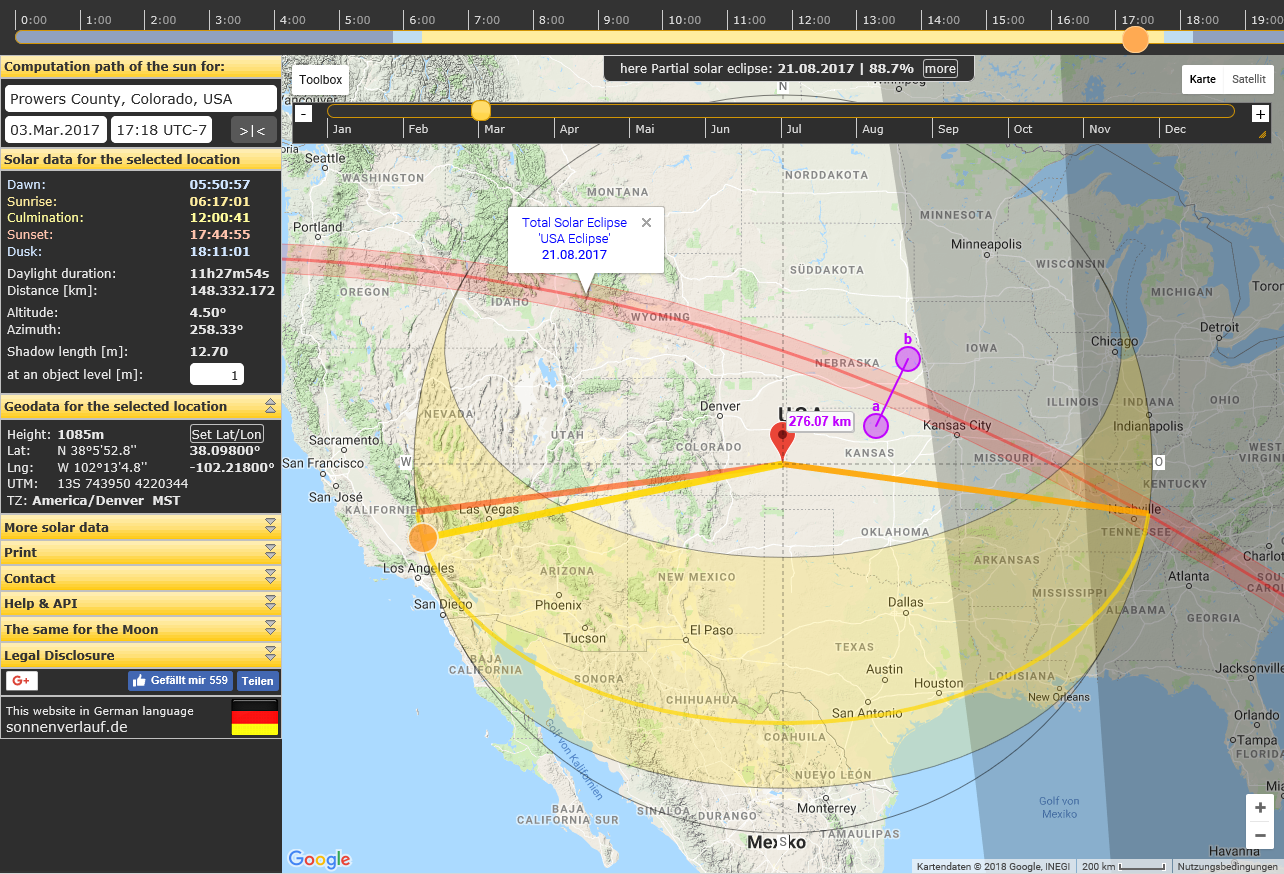
 www.suncalc.org
Here is a calculator to determine the sun position for any date and time from your exact location. With the dish mounted on a PERFECTLY plumb post, set the elevation scale on the rear of the reflector mount to the exact elevation provided by this calculator for the date and time you are testing. Also align the azimuth so there is equal shadow on either side of the LNBF feed support arm. Every few minutes, this angle and the azimuth angle will need to be reset.
www.suncalc.org
Here is a calculator to determine the sun position for any date and time from your exact location. With the dish mounted on a PERFECTLY plumb post, set the elevation scale on the rear of the reflector mount to the exact elevation provided by this calculator for the date and time you are testing. Also align the azimuth so there is equal shadow on either side of the LNBF feed support arm. Every few minutes, this angle and the azimuth angle will need to be reset.
With the dish mount elevation and the azimuth angles matching the date and time elevation of the calculator, the mirrors should reflect show the sweet spot of convergence.

SunCalc sun position- und sun phases calculator
Application for determining the course of the sun at a desired time and place with interactive map.
With the dish mount elevation and the azimuth angles matching the date and time elevation of the calculator, the mirrors should reflect show the sweet spot of convergence.
Not understanding all the lingo of your questions, ...
To explain the term 'boresight':
The boresight direction of an antenna is the direction from which the parabolic shape expects its signal (from 'infinite' distance).
That direction is: along or parallel to the symmetry axis of the parabola.
Only when the signal beam comes from the boresight direction, it is reflected to exactly the spot of the focal point of the parabola. If not, the signal beam is not mirrored to a single spot, but to a 'cloud' of points.
When the 'cloud' is small, you'll still be able to receive, if your LNB is in that cloud. But when the cloud gets bigger, reception will get worse.
That is why correct aiming of the dish is so important, when testing with mirrors.
Greetz,
A33
After some experimentation with the same exact HughesNet dish, I agree that the LNB should be a little higher than the provided arm allows, but not by a foot. Maybe a few inches. It is definitely an offset dish, just not as "offset" as other dishes.I will need to extend my LNB arm about 1' up and towards the dish in order to get to the point where all the lights came together.
I found the dish information online, and the picture does look like the LNB is higher up that the offset dishes I've seen: HughesNet .90m Antenna Reflector (box 1 / 2, 3 pk)
I used a pipe clamp to attach the LNB to the arm (pictured) and had acceptable results on 97w, 103w and 125w. My properly aligned Geosatpro 90cm dish only does about 1dB/10% better on the same transponders. If I were to keep using the HughesNet dish, I would get an adjustable LNBF mount like this one: One LNBF Bracket Replacement Bracket 40mm or 30mm | eBay
Attachments
After some experimentation with the same exact HughesNet dish, I agree that the LNB should be a little higher than the provided arm allows, but not by a foot. Maybe a few inches. It is definitely an offset dish, just not as "offset" as other dishes.
Ah! The dish has a 'flattened' bottom, so indeed no way (no flat dish-face of the parabolic surface) to calculate the offset angle from width and height of the dish.
How did you experiment?
Checking several LNB positions? Or mirror method, or water method, or several (>1) depth measurements along the vertical center of the dish, or the four measurements method in the link I gave earlier?
Just curious...
Greetz,
A33
It is easy to virtually restore the shape of the dish. All is needed is a metal ruler clamped to the edges of the dish. Like on the pictures I just made.The dish has a 'flattened' bottom, so indeed no way (no flat dish-face of the parabolic surface) to calculate the offset angle from width and height of the dish.
Attachments
No, I'm lazy and wasn't that scientific. My "experimentation" was comparing transponders on the pictured LNB setup to that of my Geosatpro 90cm. My guess about the LNB position is based on seeing other photos of this dish with the HughesNet LNB.How did you experiment?
Checking several LNB positions? Or mirror method, or water method, or several (>1) depth measurements along the vertical center of the dish, or the four measurements method in the link I gave earlier?
Just curious...
I just found some better pictures, and it looks like it needs to be a couple inches closer, not higher up. So a regular LNB bracket drilled a few inches down the arm should do the trick...?
Attachments
I'm going to go out on one last limb here. What is the elevation angle reading on the bracket versus what your install info. says it should be when you're getting the best signal you can? Just a hint. Is it very close or way out there? These Ka band dishes are engineered pretty 'tight' in the first place. If you look at some of the installer data you'll see why.
No, I'm lazy and wasn't that scientific. My "experimentation" was comparing transponders on the pictured LNB setup to that of my Geosatpro 90cm. My guess about the LNB position is based on seeing other photos of this dish with the HughesNet LNB.
Well, the calculator for non-flat dishes has made the approach of such dishes somewhat easier, I think, than experimenting and guessing.
The way to get the needed inputs:
Form a diamond on the dish face: top-right-bottom-left, with 4 equal length sides. (Just the parabolic surface, not including the rim.)
Mark the center of the diamond on the dish surface (for the depth measurements).
Then measure 1) the length of the height diagonal, and 2) the length of the width diagonal of the diamond,
and 3) the depth relative to the height diagonal, and 4) the depth relative to the width diagonal.
The needed equations for the calculation are on the internet; or I could enter these inputs in my calculator to get the resulting specs (assuming the dish has a truly paraboloid form). The latter could be easier.
Offset angle and focal length of the dish can then be 'measured/constructed' by the distance from top of dish to focus, and the distance from bottom of dish to focus.
Greetz,
A33
Last edited:
Similar threads
- Replies
- 3
- Views
- 446
- Replies
- 14
- Views
- 666
- Replies
- 1
- Views
- 378
- Replies
- 2
- Views
- 431


